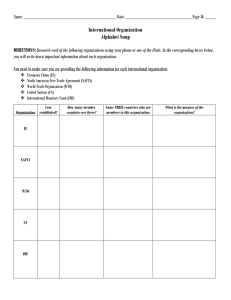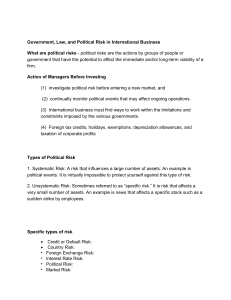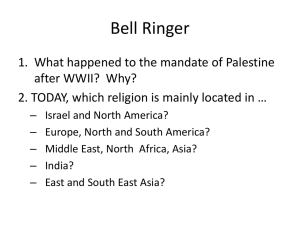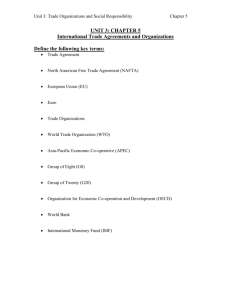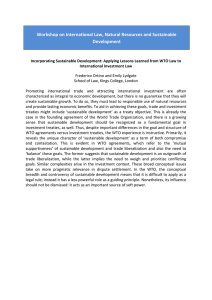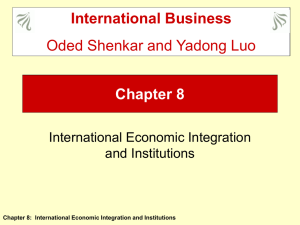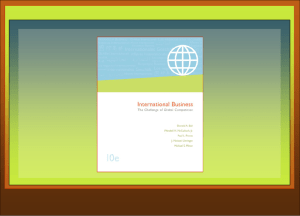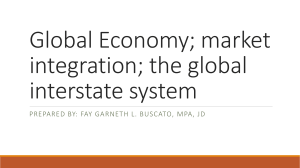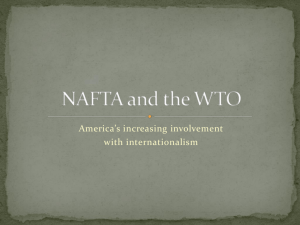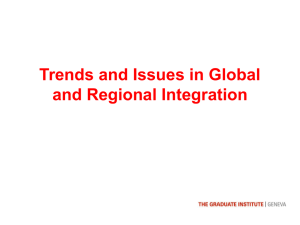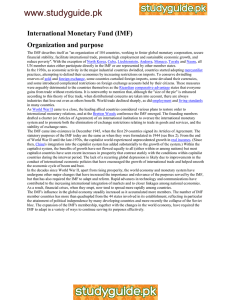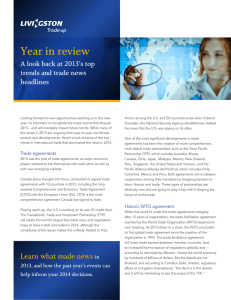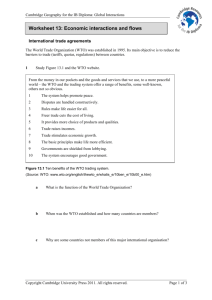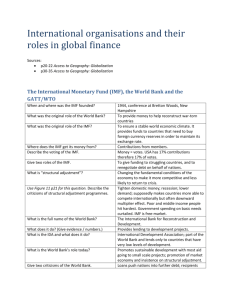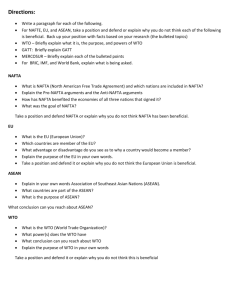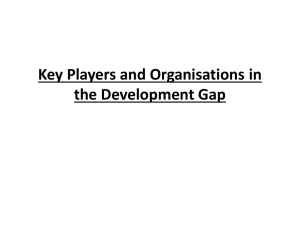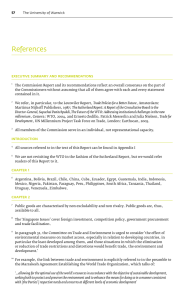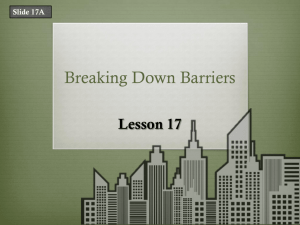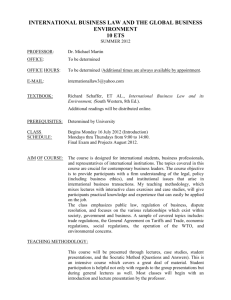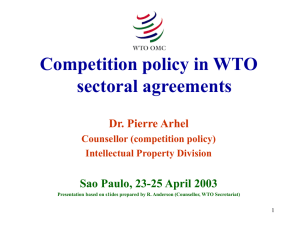Selected International Organizations
advertisement
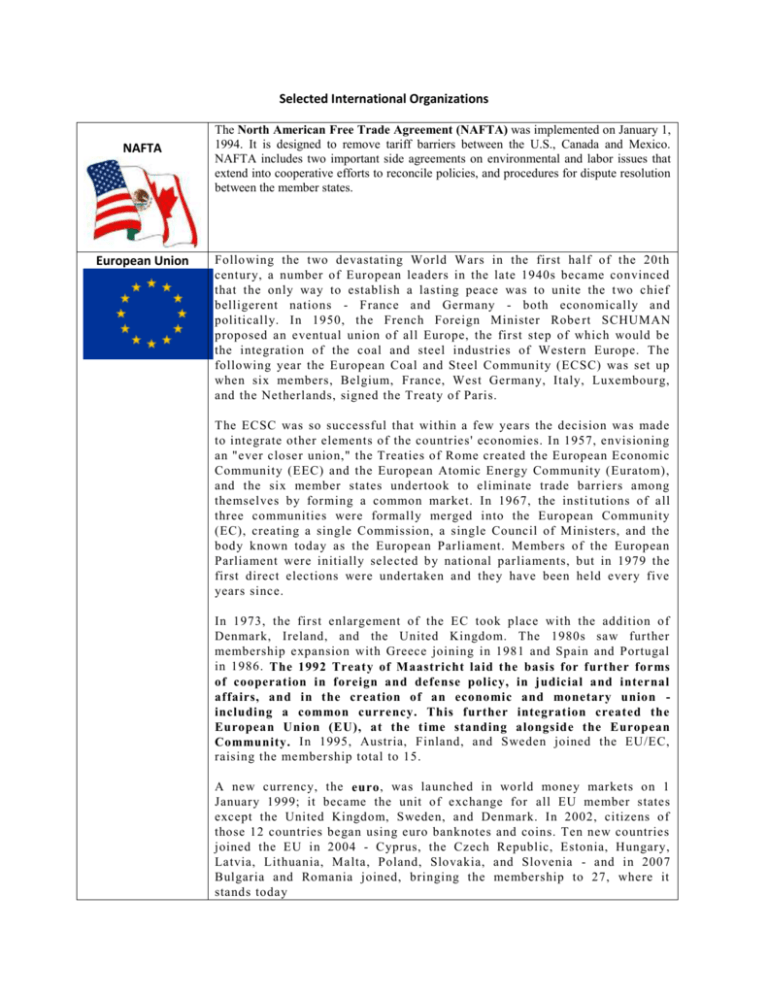
Selected International Organizations NAFTA European Union The North American Free Trade Agreement (NAFTA) was implemented on January 1, 1994. It is designed to remove tariff barriers between the U.S., Canada and Mexico. NAFTA includes two important side agreements on environmental and labor issues that extend into cooperative efforts to reconcile policies, and procedures for dispute resolution between the member states. Follo wing the two devastating World Wars in the first half of the 20th century, a number of European leaders in the late 1940s became convinced that the only way to establish a lasting peace was to unite the two chief belligerent nations - France and Germany - both economically and politically. In 1950, the French Foreign Minister Robe rt SCHUMAN proposed an eventual union of all Europe, the first step of which would be the integration of the coal and steel industries of Western Europe. The following year the European Coal and Steel Community (ECSC) was set up when six members, Belgium, France, West Germany, Italy, Luxembourg, and the Netherlands, signed the Treaty of Paris. The ECSC was so successful that within a few years the decision was made to integrate other elements of the countries' economies. In 1957, envisioning an "ever closer union," the Treaties of Rome created the European Economic Community (EEC) and the European Atomic Energy Community (Euratom), and the six member states undertook to eliminate trade barriers among themselves by forming a common market. In 1967, the insti tutions of all three communities were formally merged into the European Community (EC), creating a single Commission, a single Council of Ministers, and the body known today as the European Parliament. Members of the European Parliament were initially sele cted by national parliaments, but in 1979 the first direct elections were undertaken and they have been held every five years since. In 1973, the first enlargement of the EC took place with the addition of Denmark, Ireland, and the United Kingdom. The 1980s saw further membership expansion with Greece joining in 1981 and Spain and Portugal in 1986. The 1992 Treaty of Maastricht laid the basis for further forms of cooperation in foreign and defense policy, in judicial and internal affairs, and in the creation of an econo mic and monetary union including a common currency. This further integration created the European Union (EU), at the t ime standing alongside the European Community. In 1995, Austria, Finland, and Sweden joined the EU/EC, raising the membership total to 15. A new currency, the euro, was launched in world money markets on 1 January 1999; it became the unit of exchange for all EU member states except the United Kingdom, Sweden, and Denmark. In 2002, citizens of those 12 countries began using euro banknotes and coins. Ten new countries joined the EU in 2004 - Cyprus, the Czech Republic, Estonia, Hungary, Latvia, Lithuania, Ma lta, Poland, Slovakia, and Slovenia - and in 2007 Bulgaria and Romania joined, bringing the membership to 27, where it stands today Brief Explanation: Essentially, the WTO is a place where member governments go, to try to sort out the trade problems they face with each other. At its heart are the WTO agreements, negotiated and signed by the bulk of the world’s trading nations. But the WTO is not just about liberalizing trade, and in some circumstances its rules support maintaining trade barriers — for example to protect consumers, prevent the spread of disease or protect the environment. Expanded Explanation: The goal is to improve the welfare of the peoples of the member countries. By lowering trade barriers, the WTO’s system also breaks down other barriers between peoples and nations. At the heart of the system — known as the multilateral trading system — are the WTO’s agreements, negotiated and signed by a large majority of the world’s trading nations, and ratified in their parliaments. These agreements are the legal ground-rules for international commerce. Essentially, they are contracts, guaranteeing member countries important trade rights. They also bind governments to keep their trade policies within agreed limits to everybody’s benefit. The agreements were negotiated and signed by governments. But their purpose is to help producers of goods and services, exporters, and importers conduct their business. The result is assurance. Consumers and producers know that they can enjoy secure supplies and greater choice of the finished products, components, raw materials and services that they use. Producers and exporters know that foreign markets will remain open to them. The result is also a more prosperous, peaceful and accountable economic world. Virtually all decisions in the WTO are taken by consensus among all member countries and they are ratified by members' parliaments. Trade friction is channelled into the WTO's dispute settlement process where the focus is on interpreting agreements and commitments, and how to ensure that countries' trade policies conform with them. That way, the risk of disputes spilling over into political or military conflict is reduced. The International Monetary Fund (IMF) is an organization of 188 countries, working to foster global monetary cooperation, secure financial stability, facilitate international trade, promote high employment and sustainable economic growth, and reduce poverty around the world. The IMF has 188 member countries. It is a specialized agency of the United Nations but has its own charter, governing structure, and finances. Its members are represented through a quota system broadly based on their relative size in the global economy. Through its economic surveillance, the IMF keeps track of the economic health of its member countries, alerting them to risks on the horizon and providing policy advice. It also lends to countries in difficulty, and provides technical assistance and training to help countries improve economic management. This work is backed by IMF research and statistics United Nations The IMF works with other international organizations to promote growth and poverty reduction. It also interacts with think tanks, civil society, and the media on a daily basis. The United Nations is an international organization founded in 1945 after the Second World War by 51 countries committed to maintaining international peace and security, developing friendly relations among nations and promoting social progress, better living standards and human rights. Due to its unique international character, and the powers vested in its founding Charter, the Organization can take action on a wide range of issues, and provide a forum for its 193 Member States to express their views, through the General Assembly, the Security Council, the Economic and Social Council and other bodies and committees. The work of the United Nations reaches every corner of the globe. Although best known for peacekeeping, peacebuilding, conflict prevention and humanitarian assistance, there are many other ways the United Nations and its System (specialized agencies, funds and programmes) affect our lives and make the world a better place. The Organization works on a broad range of fundamental issues, from sustainable development, environment and refugees protection, disaster relief, counter terrorism, disarmament and non-proliferation, to promoting democracy, human rights, gender equality and the advancement of women, governance, economic and social development and international health, clearing landmines, expanding food production, and more, in order to achieve its goals and coordinate efforts for a safer world for this and future generations. The UN has 4 main purposes To keep peace throughout the world; To develop friendly relations among nations; To help nations work together to improve the lives of poor people, to conquer hunger, disease and illiteracy, and to encourage respect for each other’s rights and freedoms; To be a centre for harmonizing the actions of nations to achieve these goals.
